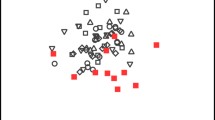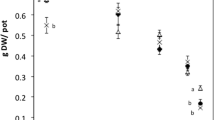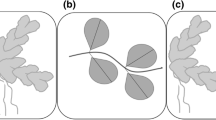Abstract
Competitive interactions between two fucoid algae with different growth forms, Fucus serratus L. and Himanthalia elongata (L.) S.F. Gray were examined both in the laboratory and on a shore of the Isle of Man, Irish Sea. The growth of germlings of both species declined with increasing density, irrespective of whether they were with cohorts or rival species, indicating that intra- and interspecific competition occurred between germlings. H. elongata suppressed the performance of F. serratus at the germling stage by virtue of its larger initial size, and at the ‘mushroom’ stage by forming a miniature canopy with the ‘caps’ of the adjacent plants. In a field experiment, the mortality of H. elongata juveniles generally increased in mixtures with F. serratus and was highest when F. serratus were 50% of the plants. At the juvenile stage, the negative effect of F. serratus on H. elongata was more severe than the other way round. This was because F. serratus grows predominantly upwards, whereas H. elongata had already begun to expand laterally at the distal end. If F. serratus survives in sparse mixed stands with H. elongata juveniles, it can overgrow them and inhibit their subsequent survivorship and growth, probably by both shading and physical sweeping. H. elongata and F. serratus maintain their discrete monospecific stands because of the varying outcomes of mutual competitive exclusion resulting from their differing growth patterns. Thus it is possible for them to co-occur at a similar shore height.






Similar content being viewed by others
References
Amsler CD, Reed DC, Neushul M (1992) The microclimate inhabited by macroalgal propagules. Br Phycol J 27:253–270
Ang PO, DeWreede RE (1992) Density-dependence in a population of Fucus distichus. Mar Ecol Prog Ser 90:169–181
Arrontes J (1993) The nature of the distributional boundary of Fucus serratus on the north shore of Spain. Mar Ecol Prog Ser 93:183–193
Begon M, Harper JL, Townsend CR (1986) Ecology: individuals, population and communities, 1st edn. Blackwell Scientific, Oxford
Brawley SH (1992) Fertilization in natural populations of the dioecious brown alga Fucus ceranoides and the importance of the polyspermy block. Mar Biol 113:145–157
Brenchley JL, Raven JA, Johnston AM (1996) A comparison of reproductive allocation and reproductive effort between semelparous and iteroparous fucoids (Fucales, Phaeophyta). Hydrobiologia 326/327:185–190
Brenchley JL, Raven JA, Johnston AM (1997) Resource acquisition in two intertidal fucoid seaweeds, Fucus serratus and Himanthalia elongata: seasonal variation and effects of reproductive development. Mar Biol 129:367–375
Brenchley JL, Raven JA, Johnston AM (1998) Carbon and nitrogen allocation patterns in two intertidal fucoids: Fucus serratus and Himanthalia elongata (Phaeophyta). Eur J Phycol 33:307–313
Carpenter RC (1990) Competition among marine macroalgae: a physiological perspective. J Phycol 26:6–12
Chapman ARO (1995) Functional ecology of fucoid algae: twenty-three years of progress. Phycologia 34:1–32
Cousens R (1991) Aspects of the design and interpretation of competition (interference) experiments. Weed Technol 5:664–673
Cousens R (1996) Design and interpretation of interference studies: are some methods totally unacceptable? NZ J For Sci 26:5–18
Creed JC (1995) Spatial dynamics of Himanthalia elongata (Fucales, Phaeophyta) population. J Phycol 31:851–859
Creed JC, Norton TA, Harding SP (1996a) The development of size structure in a young Fucus serratus population. Eur J Phycol 31:203–209
Creed JC, Norton TA, Kain JM (1996b) Are neighbours harmful or helpful in Fucus vesiculosus populations? Mar Ecol Prog Ser 133:191–201
Creed JC, Norton TA, Kain JM (1997) Intraspecific competition in Fucus serratus germlings: the interaction of light, nutrients and density. J Exp Mar Biol Ecol 212:211–223
Gibb DC (1937) Observations on Himanthalia lorea (L.) Lyngb. Linn Soc J Bot 51:11–21
Goldberg DE, Barton DE (1992) Patterns and consequences of interspecific competition in natural communities: a review of field experiments with plants. Am Nat 139:771–801
Hay ME (1986) Functional geometry of seaweeds: ecological consequences of thallus layering and shape in contrasting light environments. In: Givnish TJ (ed) On the economy of plant form and function. Cambridge University Press, Cambridge, pp 635–636
Khan MA, Putwain PD, Bradshaw AD (1975) Population interrelationships. 2. Frequency-dependent fitness in Linum. Heredity 34:145–163
Kitching JA (1987) The flora and fauna associated with Himanthalia elongata (L.) S.F. Gray in relation to water current and wave action in the Lough Hyne Marine Nature Reserve. Estuar Coast Shelf Sci 25:663–676
Knight M, Parke M (1950) A biological study of Fucus vesiculosus L. and F. serratus L. J Mar Biol Assoc UK 29:439–514
Lewis JR (1964) The ecology of rocky shores. English Universities Press, London
Lüning K (1990) Seaweeds: their environment, biogeography, and ecophysiology. Wiley, New York
McLachlan J (1974) Effects of temperature and light on growth and development of embryos of Fucus edentatus and F. distichus spp. distichus. Can J Bot 52:943–951
Moss B (1969) Apical meristems and growth control in Himanthalia elongata (S.F. Gray). New Phytol 68:387–397
Moss B, Mercer S, Sheader A (1973) Factors affecting the distribution of Himanthalia elongata (L.) S.F. Gray on the north-east coast of England. Estuar Coast Shelf Sci 1:233–243
Norton TA (1986) The ecology of macroalgae in the Firth of Clyde. Proc R Soc Edinb 90:255–269
Norton TA (1991) Conflicting constraints on the form of intertidal algae. Br Phycol J 26:203–218
Olson AM, Lubchenco J (1990) Competition in seaweeds: linking plant traits to competitive outcomes. J Phycol 26:1–6
Pearson GA, Brawley SH (1996) Reproductive ecology of Fucus distichus (Phaeophyceae): an intertidal alga with successful external fertilization. Mar Ecol Prog Ser 143:211–223
Pearson GA, Serrão EA, Brawley SH (1998) Control of gamete release in fucoid algae: sensing hydrodynamic conditions via carbon acquisition. Ecology 79:1725–1739
Ramon E (1973) Germination and attachment of zygotes of Himanthalia elongata (L.) S.F. Gray. J Phycol 9:445–449
Russell G (1990) Age and stage in seaweed population: a cautionary tale. Br Phycol J 25:245–249
Silvertown J, Lovett Doust J (1993) Introduction to plant population biology. Blackwell Scientific, Oxford
Sokal RR, Rohlf FJ (1981) Biometry, 2nd edn. Freeman, New York
Stengel DB, Wilkes RJ, Guiry MD (1999) Seasonal growth and recruitment of Himanthalia elongata (Fucales, Phaeophyta) in different habitats on the Irish west coast. Eur J Phycol 34:213–221
Underwood AJ (1986) The analysis of competition by field experiments. In: Kikkawa J, Anderson DJ (eds) Community ecology: pattern and process. Blackwell, Oxford, pp 240–268
Underwood AJ (1997) Experiments in ecology: their logical design and interpretation using analysis of variance. Cambridge University Press, Cambridge
Vadas RL, Johnson S, Norton TA (1992) Recruitment and mortality of early post-settlement stages of benthic algae. Br Phycol J 27:331–351
Worm B, Chapman ARO (1998) Relative effects of elevated grazing pressure and competition from a red algal turf on two post-settlement stages of Fucus evanescens C. Ag. J Exp Mar Biol Ecol 220:247–268
Zar JH (1984) Biostatistical analysis, 2nd edn. Prentice-Hall, London
Acknowledgements
We would like to thank anonymous reviewers for very useful comments on the paper. This paper was partially supported by a grant from Wonkwang University in 2004.
Author information
Authors and Affiliations
Corresponding author
Additional information
Communicated by O. Kinne, Oldendorf/Luhe
Rights and permissions
About this article
Cite this article
Choi, H.G., Norton, T.A. Competitive interactions between two fucoid algae with different growth forms, Fucus serratus and Himanthalia elongata. Marine Biology 146, 283–291 (2005). https://doi.org/10.1007/s00227-004-1441-4
Received:
Accepted:
Published:
Issue Date:
DOI: https://doi.org/10.1007/s00227-004-1441-4




